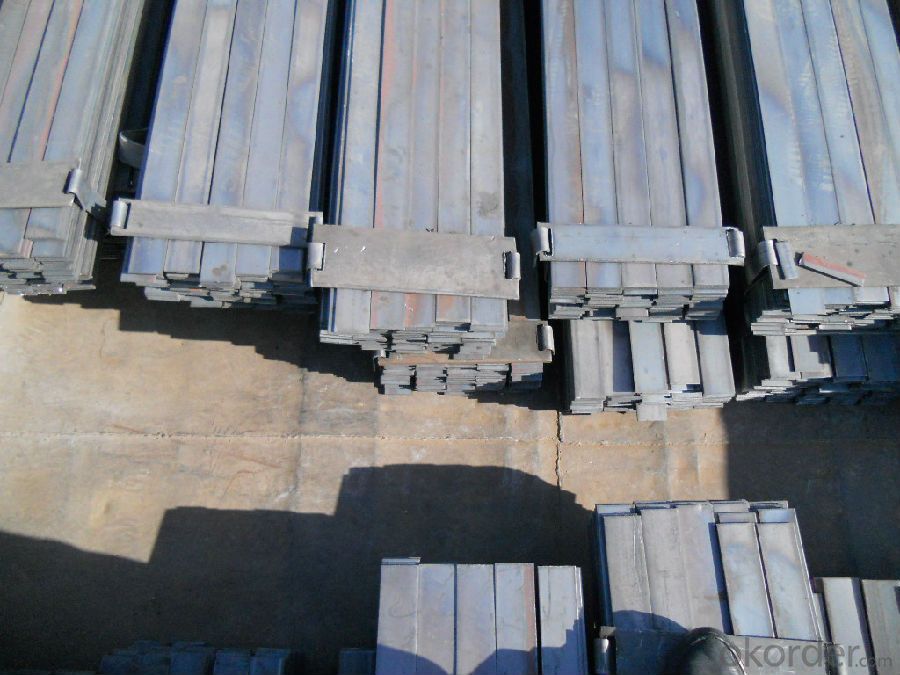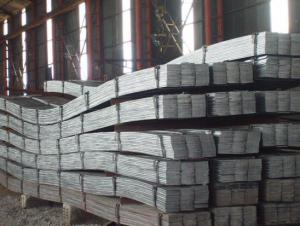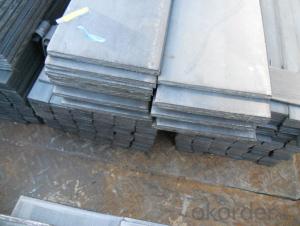Slitting Steel Flat Bars A36, SS400, Q235
- Loading Port:
- Shanghai
- Payment Terms:
- TT OR LC
- Min Order Qty:
- 25 m.t.
- Supply Capability:
- 200000 m.t./month
OKorder Service Pledge
OKorder Financial Service
You Might Also Like
Specification
Product Description:
OKorder is offering Slitting Steel Flat Bars A36, SS400, Q235 at great prices with worldwide shipping. Our supplier is a world-class manufacturer of steel, with our products utilized the world over. OKorder annually supplies products to African, South American and Asian markets. We provide quotations within 24 hours of receiving an inquiry and guarantee competitive prices.
Product Applications:
Slitting Steel Flat Bars A36, SS400, Q235 are ideal for structural applications and are widely used in the construction of buildings and bridges, and the manufacturing, petrochemical, and transportation industries.
Product Advantages:
OKorder's Slitting Steel Flat Bars A36, SS400, Q235 are durable, strong, and wide variety of sizes.
Main Product Features:
· Premium quality
· Prompt delivery & seaworthy packing (30 days after receiving deposit)
· Can be recycled and reused
· Mill test certification
· Professional Service
· Competitive pricing
Product Specifications:
Manufacture: Slitting Steel Flat Bars A36, SS400, Q235
Slitting precision (width) : 0.5 mm or less
Raw material: Q235B, Q345B, Q235-1 b
crosscutting precision (length) : 2 mm or less
Processing: the thickness of 2.0-16 mm;
Shear length: 2000 mm above
Wide degree: 15-1250 - mm;
Leveling precision: 1-2 MM square
Packaging: Export packing, nude packing, bundled
FAQ:
Q1: How many tons of Slitting Steel Flat Bars A36, SS400, Q235 could be loaded in containers?
A1: Usually the steel products are delivered by bulk vessel because of the large quantity and the freight. However, there are no bulk vessel enter some seaports so that we have to deliver the cargo by containers. The 6m steel product can be loaded in 20FT container, but the quantity is changed according to the size, usually from 18tons to 25tons.
Q2: How do we guarantee the quality of Slitting Steel Flat Bars A36, SS400, Q235?
A2: We have established an advanced quality management system which conducts strict quality tests at every step, from raw materials to the final product. At the same time, we provide extensive follow-up service assurances as required.
Q3: What is the difference between actual weight and theoretical weight?
A3: All the section steel has two weights: actual weight and theoretical weight. Actual weight is the weighing out when the product delivered from the mill. Theoretical weight is calculated by pieces. The invoice can be based on each of them as your request.
Images:


- Q: Can steel flat bars be used in the manufacturing industry?
- Steel flat bars are widely used in the manufacturing industry for their versatility, strength, and durability. They find extensive applications in the production of machinery, tools, construction materials, and automotive components. These bars serve as structural supports, frames, or reinforcements in manufacturing processes. Moreover, they can be easily welded, drilled, and shaped, making them suitable for various fabrication techniques. The exceptional mechanical properties and capacity to meet diverse application requirements make steel flat bars a favored option in the manufacturing industry.
- Q: How do steel flat bars compare to stone flat bars?
- Steel flat bars and stone flat bars have distinct differences in terms of material composition, physical properties, and applications. Steel flat bars are made from alloyed steel, offering high strength, durability, and corrosion resistance. They are versatile and widely used in construction, manufacturing, and engineering projects due to their excellent load-bearing capabilities and ability to withstand extreme conditions. On the other hand, stone flat bars are typically made from natural or engineered stone materials, which provide a unique aesthetic appeal and can be used in decorative applications. However, stone flat bars may have limitations in terms of strength and flexibility compared to steel flat bars. Therefore, the choice between steel and stone flat bars depends on the specific purpose and desired characteristics required for the intended use.
- Q: Can steel flat bars be welded?
- Yes, steel flat bars can be welded. Welding is a common and widely used method for joining or repairing steel materials, including flat bars. The process involves heating the steel to its melting point and then fusing the two pieces together using a welding electrode or filler material. The resulting weld creates a strong and durable bond, making it suitable for various applications in construction, manufacturing, and other industries where steel flat bars are commonly used. However, it is important to follow proper welding procedures and techniques to ensure a successful and structurally sound weld.
- Q: Are steel flat bars available in different colors?
- No, steel flat bars are typically not available in different colors. They are usually sold in their natural steel color, which is a metallic grey or silver shade.
- Q: Are steel flat bars available in different surface roughness options?
- Yes, steel flat bars are available in different surface roughness options.
- Q: Can steel flat bars be bent or shaped easily?
- Bending or shaping steel flat bars is influenced by several factors, including bar thickness, steel type, and desired bending degree. Thinner bars are generally easier to bend than thicker ones. The malleability and ductility of the steel type also affect the ease of bending. Various methods can be used to shape or bend steel flat bars, such as hydraulic presses, metal bending machines, or heat application to soften the steel. However, it is important to emphasize that specialized tools and expertise are necessary, especially for achieving precise angles or complex shapes. In conclusion, bending or shaping steel flat bars is not a simple task and requires appropriate tools, techniques, and knowledge to achieve the desired outcome.
- Q: How do you prevent scaling or oxidation on steel flat bars during heat treatment?
- To prevent scaling or oxidation on steel flat bars during heat treatment, there are several measures that can be taken: 1. Utilize a protective atmosphere: An effective method involves subjecting the steel flat bars to heat treatment in a controlled atmosphere, such as vacuum or an inert gas environment like nitrogen or argon. This approach ensures that the steel remains isolated from oxygen, thereby minimizing the potential for oxidation. 2. Employ a protective coating: Another approach is to apply a protective coating onto the flat bars' surface prior to heat treatment. This can be accomplished by utilizing various coatings like ceramic, refractory, or metallic coatings. These coatings serve as a barrier between the steel and the surrounding atmosphere, effectively preventing oxidation. 3. Implement a reducing atmosphere: Heat treating the steel in a reducing atmosphere, such as hydrogen or a hydrogen-nitrogen mixture, can also prevent scaling and oxidation. The reducing atmosphere aids in eliminating any present oxygen and inhibits the formation of oxides on the steel's surface. 4. Control the heating process: The proper control of the heating process plays a crucial role in preventing scaling and oxidation. It is important to avoid rapid heating and cooling rates, as they can result in excessive scaling. Instead, employing slow and controlled heating with appropriate temperature ramping can help minimize the likelihood of oxidation. 5. Ensure surface cleanliness: Before heat treatment, it is essential to thoroughly clean the surface of the steel flat bars. Any contaminants, such as dirt, grease, or oils, can contribute to scaling and oxidation. Employing surface cleaning methods like degreasing, pickling, or mechanical cleaning can effectively eliminate these contaminants. By implementing these preventive measures, the risk of scaling or oxidation on steel flat bars during heat treatment can be significantly reduced, thereby ensuring the production of high-quality final products.
- Q: The difference between galvanized round bar and galvanized flat steel
- It has been widely used in the fields of hardware, construction, automobile, shipbuilding, petrochemical, machinery, medicine, food, electricity, energy, space, etc.. The most extensive machining of general machine parts, general rod type steel parts, CD pole, bolt, nut.
- Q: Can steel flat bars be used for making hand tools or gardening equipment?
- Yes, steel flat bars can be used for making hand tools or gardening equipment. Steel is a strong and durable material, making it suitable for various applications in tool and equipment manufacturing.
- Q: What is the minimum order quantity for steel flat bars?
- The minimum order quantity for steel flat bars can vary depending on the supplier or manufacturer. Typically, the minimum order quantity is determined by factors such as production costs, transportation logistics, and customer demand. However, it is common to see minimum order quantities ranging from 1 to 10 metric tons. It is advisable to contact the specific supplier or manufacturer to inquire about their minimum order requirements and negotiate accordingly.
Send your message to us
Slitting Steel Flat Bars A36, SS400, Q235
- Loading Port:
- Shanghai
- Payment Terms:
- TT OR LC
- Min Order Qty:
- 25 m.t.
- Supply Capability:
- 200000 m.t./month
OKorder Service Pledge
OKorder Financial Service
Similar products
Hot products
Hot Searches
Related keywords




























